STEM education and the maker movement have flooded our nation’s schools, making project-based learning much easier to mark off of the instructional “must do” checklist toward meeting new criterion and readying students for a career. Our school districts are feeling the pressure to be innovative and find new ways to engage students with technology while adhering to the newly implemented Common Core Standards and ensure students are prepared for what happens following graduation. The buzz phrase these days is “21st century skills” — and students must have them.
But, I am forced to ask, what about the traditional career paths that have evolved with the changing face of technology, but whose general perception has lagged behind? Industries such as manufacturing continue to be misunderstood and believed to be dirty, grungy jobs for the under-educated, which couldn’t be further from the truth. Why are we not exposing students to these careers, which are not only available, but also are incorporating the latest technology?
The manufacturing of today includes advanced manufacturing design, automation and innovation of both hardware and software. It requires a high level of expertise and critical thinking. In addition, manufacturers are willing to pay for their employees to receive a higher education.
And you better believe there will be a job readily available for those interested. Over the next decade, nearly 3.5 million manufacturing jobs will need to be filled, but the skills gap is expected to result in 2 million of those jobs going unfilled. The greatest shortage currently is in employees with technology and computer skills.
I previously worked for a school district in a public relations role highlighting all the worthwhile projects our teachers were implementing in the classroom. If you had mentioned to me that we should be introducing our students to a career in manufacturing, I would have balked or judged, believing those jobs were only for “certain” students.
After working for the past month with SWPA BotsIQ, a regional high school robotics competition through the National Robotics League whose mission is to get students involved in manufacturing careers, I am embarrassed of my preconceived notions of this career path and the people who work in the industry.
I have taken tours of facilities like Hammill Manufacturing and I have had the opportunity to speak with manufacturing industry leaders, as well as high school educators and students looking toward a future in the field. I have read news articles and the latest research, as well as become aware of recent advances in manufacturing, and my eyes have been opened.
Not everyone looking to work in a technology career will be employed by Google, Apple or Microsoft.
Manufacturing not only matters, it’s critical to the success of our economy. According to the National Association of Manufacturers and U.S. Bureau of Labor Statistics, every dollar spent in manufacturing adds $1.37 to the U.S. economy, and every 100 jobs in a manufacturing facility creates an additional 250 jobs in other sectors. Americans see this and believe it to be true, yet a new Manufacturing Institute study found only one in three would encourage their children to pursue manufacturing careers.
Americans have clung to an outdated belief that manufacturing is low-skilled, menial work. According to the Fabricators and Manufacturers Association (FMA), 61 percent of teenagers say they’d prefer to pursue a “professional” career, not seeing manufacturing as a chance for career development or advancement.
Let me tell you, manufacturing has changed. Factories are now modern, state of the art foundations of innovation and technology. Factory workers now specialize in engineering, electronics, information technology, robotics, mechatronics, design and research and development. Manufacturing jobs are challenging, high-tech and require creativity and problem-solving capabilities. And it’s precisely that reason that manufacturers pay well; the average manufacturing worker earned more than $77,000 in 2013.
Let’s be real. Not everyone looking to work in a technology career will be employed by Google, Apple or Microsoft. So why not consider Caterpillar, Alcoa or Haas Automation instead?
It’s simple, really, but the change in mindset has to begin with you.
